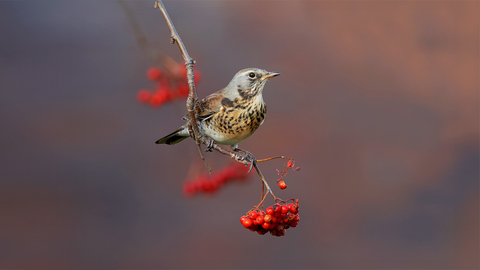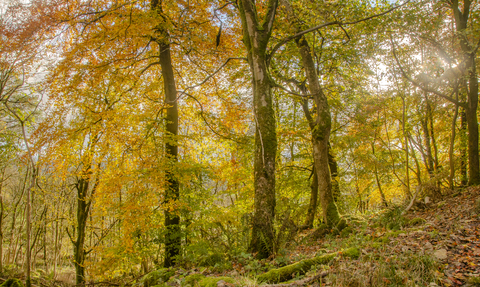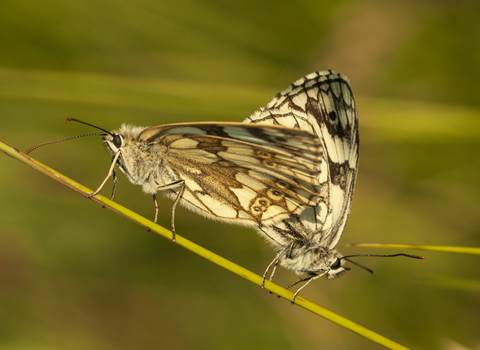
♂ Yellowhammer © Jon Traill
Hawthorn trees in full bloom © Jon Traill

Fieldfare - (C) Richard Steel/2020VISION

A red-tailed bumblebee and common carder bee on Greater knapweed, photo credit - Simon Tull
Kippax Meadows Nature Reserve
Location
Know before you go
Dogs
Please respect the resident wildlife and keep dogs on a short lead.
When to visit
Opening times
Open at all times. We recommend a 1 hour trip for this reserve. To broaden out your wildlife experience, carry on to one of our other reserves – Owl Wood and Pit Plantation, Townclose Hills and Ledston Luck are all within a mile or two’s walk.Best time to visit
April to SeptemberAbout the reserve
An ideal spot for some fresh air and exercise, or a family outing with a picnic, Kippax Meadows is tucked away on the edge of Kippax village, with a network of accessible paths opening up this green oasis for visitors to get close to nature.
From the sensory gardens beds by the Cromwell Rise entrance to the botanically diverse grasslands that grow on sandstone and magnesian limestone, colourful flowers attract bumblebees and butterflies, including common blues, meadow browns, peacocks, small skippers, small tortoiseshells, and small and large whites.
Smooth tare, greater knapweed, common spotted orchid, meadow cranesbill and bee orchid are among the many flowers that light up the meadow in summer, and work continues around the site to encourage a greater diversity of species.
Keep your eyes peeled for small mammals, and remember to keep looking up – red kites, buzzards and kestrels can often be spotted flying overhead, and sometimes perch on trees or bushes.
Spring and summer are the best seasons for a saunter around Kippax Meadows. In spring, listen for the calls of returning chiffchaffs, and yellowhammers, linnets and bullfinches singing for a mate from scattered hawthorn bushes.
During the summer months, take time to wander through the meadows, enjoy the buzzing of bumblebees, and see which species of flowers and butterflies you can discover.
Habitat
Contact us
About
Kippax Meadow is a Site of Ecological and Geological Importance (SEGI) consisting of a mosaic of species rich grassland and dynamic scrub habitats. The underlying geology is predominantly Pennine Middle Coal Measures Formation (sandstone) but at the northern edge of the grassland there is an outcrop of magnesium limestone.
The botanically diverse grasslands are both calcareous and neutral and support a number of notable and regionally scarce plant species including smooth tare, dewbury, common spotted orchid, southern marsh orchid and bee orchid.
The grassland supports a good range of butterflies and bumblebee species such as the common blue, meadow brown, small tortoiseshell, small and large white, peacock and small skipper. Kestrels, red kites and common buzzards can be seen flying over this site and occasionally perched on the scrub. Small mammals such as hedgehogs have also been recorded on site.
Using the accessible path network found throughout the site, visitors in spring will experience birds such as bullfinch, yellowhammer and linnet proclaiming their territories and singing for a mate from the areas of scattered hawthorn scrub. Throughout summer months you can picnic or wander through the meadows which will be ablaze with colour and crackle with the sound of bumble bees, butterflies and other insects.
Kippax Meadows is part of the green corridor in the Lower Aire Valley in Leeds which is owned by Leeds City Council and managed in partnership with the Trust.
Seasonal highlights
- Spring: Birds - Chiffchaff; Bullfinch; Yellowhammer
- Summer: Plants - Common spotted orchid; Bee orchid; Southern marsh orchid; Invertebrates - Common blue; Small skipper
- Autumn: Birds - Fieldfare; Redwing
- Winter: Birds - Linnet
Directions
Public transport
Buses run between Leeds and Castleford, stopping at Kippax.
By car
From the north leave the M1 South at junction 46 onto the A63 (Selby Road). Take a right turn onto the A656, then a right to Kippax on the B6137. Take the first exit on the roundabout down Butt Hill, then bear left onto Brigshaw Lane. Parking is either on the roadside or in the bowling club car park. Reserve access off Cromwell Rise.
Did you know?
Bullfinches were once considered a serious pest in orchards. Henry VIII condemned their 'criminal attacks' on the new buds of fruit trees, and an Act of Parliament declared that one penny would be paid for every bird killed.

The autumn colours were even more beautiful when the sun came out
Photo Credit - Telling our Story Volunteer, Sara



